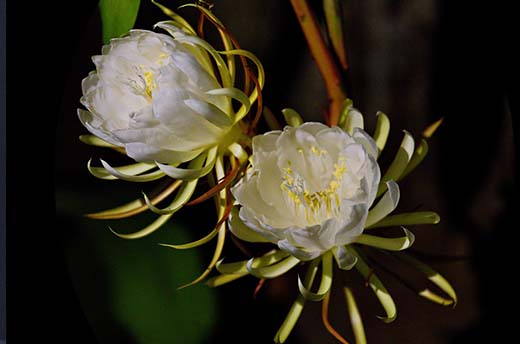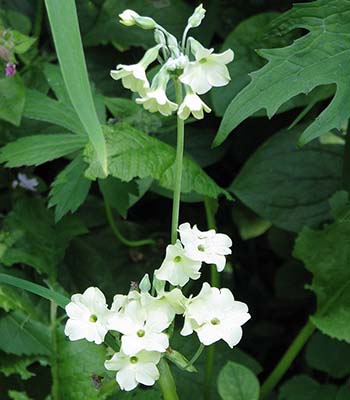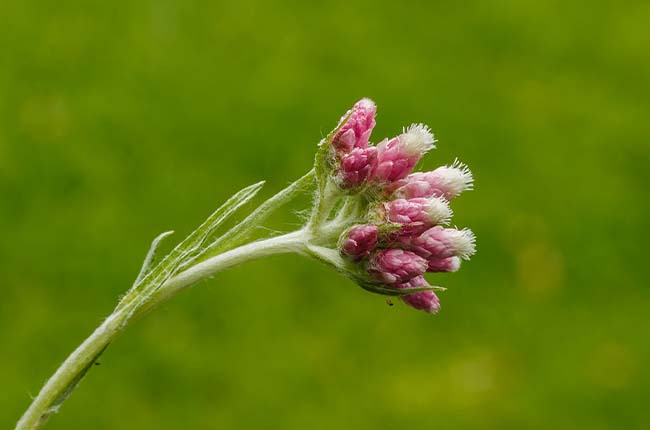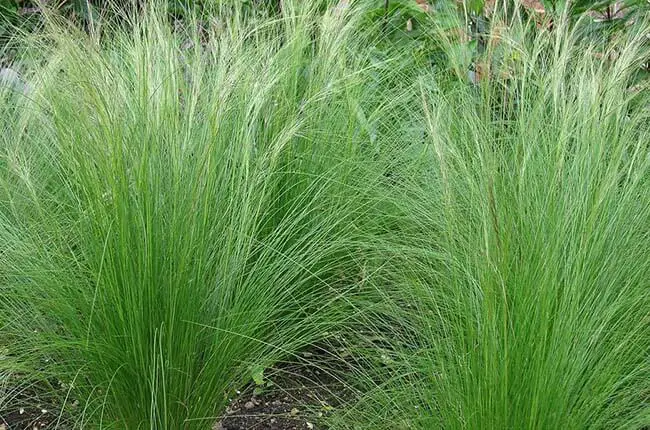Despite their vital role in nature, bees are not always the most welcomed visitors.
Whether it’s an allergy or fear of their stings, there are a handful of reasons why you may prefer not to have them in your yard.
So, what plants can you have in the garden that do not attract bees?
You can have a bee-free garden with plants that bloom at night, in early spring or late fall, produce trumpet-shaped blooms with deep tunnels inaccessible to bees, small blooms, and blooms with a repellant odor. Also, plants that self-pollinate or pollinate by wind do not develop features that attract bees.
In this article, we have found 22 plant ideas for your bee-free garden.
Let’s get started.
What Does Not Attract Bees
- Non-flowering plants
Plants that are wind-pollinated and self-pollinated do not develop features such as flowers with nectar and pollen to attract bees to pollinate. If a plant lacks these, bees will show little interest.
- Night-flowering plants
Flowers that open at night do not attract bees which are active only in the daytime. Such flowers do not depend on bees to pollinate.
The Evening Primrose for example depends on the wind to self-pollinate while the night-blooming Cereus and Datura depend on nocturnal insects such as moth to pollinate. Their blooms are usually short-lived so they open in the evening and wilt within 24 hours.
- Early/Late-blooming plants
Bees typically emerge for the year in late spring as the warm-weather blooms begin to flower. If a plant tends to flower earlier or later in the season, like Witch Hazel, bees will not be active enough to visit the plant.
- Inconspicuous blooms
Flowers with small blooms such as evening pussy toes (Antennaria dioica) are not very popular among bees.
- Trumpet-shaped blooms
Bees prefer two shapes of blooms for easy access to the nectar. Open blooms, which are shaped like a bowl or dish, provide easy access for bees. Examples include sunflower, geranium, and poppy.
Bell shapes (e.g. nasturtium, English bluebells, bell flowers, foxgloves) are also their favorites because the shape of the flowers is shallow.
On the other hand, trumpet-shaped blooms (e.g. trumpet flowers, amaryllis) are less appealing to bees because it is not easy to access the deep tunnels with nectar hidden away. Rather, those with deep tubular throats are pollinated by hummingbirds.
- Smelly blooms
As most sentient beings, bees are attracted to the sweet smell of nectar emitted from flowering plants. There are, however, some plants that develop pungent odors to deter bees and insects from visiting. Examples include pawpaw trees, wormwood, and Eucalyptus.
- Conifer trees
The cones produced by coniferous trees (such as firs, and cedars) produce little offerings for bees. The seeds they need to spread come encased in cones and their pollen is spread by the wind.
Flowers that don’t attract bees
1. Forsythia
Forsythia does not attract bees despite their bright yellow blooms. They flower early around early spring in March/April. By the time they have bloomed and released pollen, bees have only just started to emerge.

(David Rasp, CC BY-SA 4.0, via Wikimedia Commons)
2. Geranium
Geraniums have a strong, unique smell that is repelling to bees. Despite their bright colored flowers which would make them a beautiful addition to a garden, bees are mostly unable to detect the color red.
3. Chrysanthemum
Their petal structure, known as a double corolla, makes accessing the pollen difficult. Bees will stay away from mums in search of a quicker meal.

(Agnieszka Kwiecień, Nova, CC BY-SA 4.0, via Wikimedia Commons)
4. Night-blooming Cereus
These stunning night-flowering succulents from the Epiphyllum family (also known as “orchid cactus”) have large cup-shaped and highly fragrant blooms. However, they do not attract daytime pollinators such as bees and butterflies.
They attract nocturnal insects such as moths to pollinate.
They open their blooms only one night a year and wilt in the morning.

5. Foxglove
The shape of their blooms prevents bees from visiting the flower. Although it is high in nectar, the bell-shaped flower can only be accessed by the long, thick beak of a hummingbird.
6. Beardtongues (Penstemon)
Penstemon has two natural bee deterrents. The long bell shape of the flower keeps bees from access, and their red coloring means bees struggle to identify them.
7. Evening Primrose (Primula Alpicola)
Various Evening primrose species bloom in the evening and wilt within 24 hours. They are self-pollinated and do not attract bees.

(peganum from Henfield, England, CC BY-SA 2.0, via Wikimedia Commons)
8. Devil’s trumpet (Datura)
Datura is a night-blooming flower that is pollinated by nocturnal insects like moths. Their trumpet-shaped flower also makes access for bees near impossible.
9. Pussy toes (Antennaria dioica)
This perennial herb is native to the cold mountains grasslands. Their small, inconspicuous flower clusters that resemble the toes of a cat’s paw do not attract bees.

Dominicus Johannes Bergsma, CC BY-SA 4.0, via Wikimedia Commons)
Shrubs that don’t attract bees
10. Wormwood
This herbaceous plant covered in silky gray hairs is mostly grown as ornamental grass. It is wind-pollinated, does not have flowers, and thus does not attract bees.
It also has a strong distinctive aroma like sage that keeps most insects away, including bees.
11. Witch Hazel
Witch hazel does not compete with other flowering plants for pollinators and blooms in late fall to early winter from September to December with a show of yellow flowers.
Since their blooming season is far too late and cold for the bees to be out collecting nectar, the plant’s flowers mostly go unpollinated, resulting in few fruits.
12. Ornamental grasses
Most decorative grasses are wind-pollinated and thus do not develop features to attract bees.
You can grow Mexican feathergrass (Stipa tenuissima), Tufted hair grass (Deschampsia cespitosa) in a sunny location, or Black grass (Ophiopogon nigrescens) and Japanese ryegrass (Hakonechloa macra) in the shade.
Although they do not produce flowers, they do produce pollens which may still attract some bees occasionally.

(Alex Lomas, CC BY 2.0, via Wikimedia Commons)
13. Juniper
A juniper bush won’t attract any bees because there is no work for them to do. These shrubs are wind-pollinated and don’t have to rely on any insects.
Vines that don’t attract bees
14. Grapevines
Grapevines have small inconspicuous flowers which do not attract bees. It is actually the grapes (the fruits) that attract bees. But this happens only when they cannot find flowers for nectar. They would feast on fruits such as grapes, plums, peaches, etc.
Apart from the grapevine, the invasive vine of ivy, on the other hand, does attract bees. When the plant flowers from early September to early November, its small flowers actually do attract bees who are on the lookout for the last nectar before winter.
Fruit trees that don’t attract bees
It is highly debatable whether honey bees feast on fruits. Some argue that bees cannot pierce through the skin of fruits, others claim that bees often feast on fruits including mulberry, plums, grapes, peaches if they cannot find nectars from flowers.
15. Pawpaw trees
Pawpaws are ancient trees that evolved to attract flies and beetles as pollinators. Their unique odor is said to resemble decay, which does not attract sweet-seeking bees.
16. Fig trees
Fig trees bloom internally, meaning access to the pollen is limited to the fig wasp which will make its home inside while pollinating the plant.
Trees that don’t attract bees
17. Gingko
Ginkgo is one of the oldest species of trees in the world and does not rely on the bee to pollinate.
Gingkos produce a noticeably stinky fruit, and the odor combined with a lack of flowers means there is nothing of use to the bees.

(Crusier, CC BY-SA 3.0, via Wikimedia Commons)
18. Pine
Pine trees do not flower, nor do they rely on pollinators like bees. Instead, their cones are dropped containing male pollen for the wind to carry to the female seeds of another pine cone.
19. Oak
Generally, oaks are not very popular for bees because they are wind-pollinated and do not have any flowers.
However, when flower nectar is limited, the hungry bees will visit the sweet substances called honeydew secreted by oaks.
20. Willow
Willows have survived mostly as wind pollinators. The weeping branches sway in the wind depositing pollen in all-new locations. Since willows bloom so early in the season, it is unlikely bees will have come out to claim the nectar from their flowers.
21. Bamboo
Bamboo plants do not rely on insects as pollinators. Instead, the plant will drop the seeds to the ground to grow a new plant.
The tubular shape of the trunk has been known to provide shelter for bees but is not the most sought-after shelter.
22. Eucalyptus
The Eucalyptus trees secrete an essential oil that smells like peppermint. Though it has been debated whether bees are attracted to mint, this particular odor can be repelling for bees.
Conclusion
To prevent bees from visiting your garden is to have plants that won’t flower. With no nectar to consume, bees are not likely to hang around.
If you are looking to add some color to your garden through flowers without the threat of bees, pay attention to the shape of the bloom, the time of blooming, and the scent to set up the best version of your bee-free garden.
Happy gardening!
Related:
14 Fragrant Succulents & Cacti (You Will Love)
References:
Rhodes, P. (2013). The Importance of Bees in Natural and Agricultural Ecosystems. U.S Dept. of Agriculture
Shipman, M. (2011). What do bees see? And how do we know? NC State.
- Top 6 Drip Irrigation Systems for Raised Beds (2025) - January 31, 2025
- Top 10 Orchid Fertilizers: A Comprehensive Review (2025) - January 16, 2025
- Top 6 Slow-Release Fertilizers for Houseplants & Veggies (2025) - January 15, 2025

